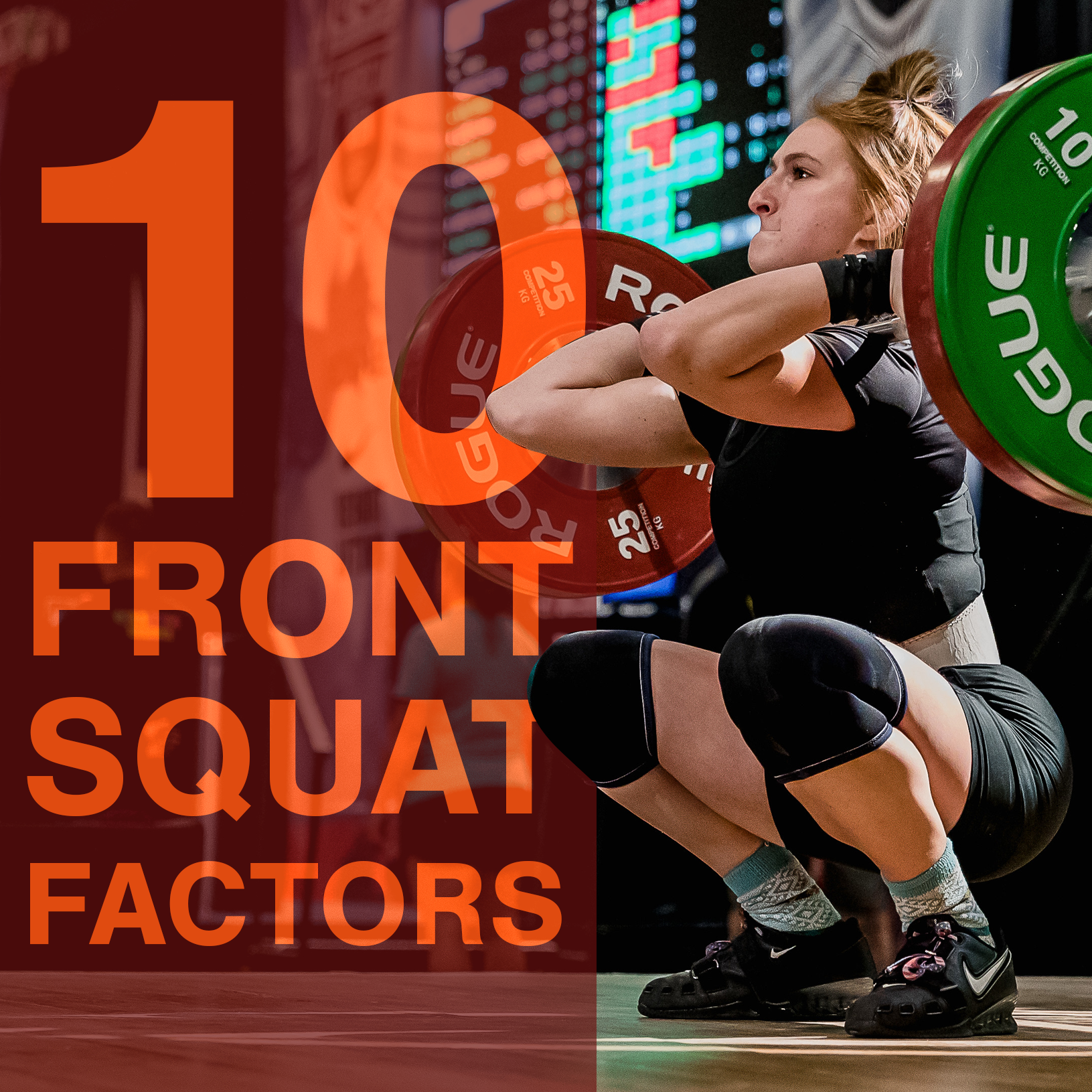10 Front Squat Factors

What Athletes Need to Know about the Front Squat
Kim Goss
BFS has always believed that the back squat should be the primary leg exercise for athletes. After that, there are many other challenging leg exercises that can be a part of a coach’s weight training toolbox. The front squat is one such exercise, but is it for you?
First, consider that the front squat is not a wimpy exercise. Although more weight can be used in the back squat, considerably heavy weights have been raised in the front squat. American weightlifters Paul Anderson and Mark Henry – going all the way down and using no special equipment – lifted over 700 pounds in this exercise. Who is the GOAT?
 One contender is 2x Olympic champion in weightlifting Hossein Rezazadeh, an Iranian super heavyweight. He reportedly could front squat 749 pounds – you can watch him on Youtube lifting 617 for two reps relatively easily without knee wraps and bouncing out of the bottom. However, Derek Kendall can be seen on Youtube grinding up 855 pounds! Moving down a few bodyweight classes, at a bodyweight of 187 pounds, 3x Olympic champion Pyrros Dimas of Greece reportedly lifted more than 600 pounds.
One contender is 2x Olympic champion in weightlifting Hossein Rezazadeh, an Iranian super heavyweight. He reportedly could front squat 749 pounds – you can watch him on Youtube lifting 617 for two reps relatively easily without knee wraps and bouncing out of the bottom. However, Derek Kendall can be seen on Youtube grinding up 855 pounds! Moving down a few bodyweight classes, at a bodyweight of 187 pounds, 3x Olympic champion Pyrros Dimas of Greece reportedly lifted more than 600 pounds.
How much should you be able to lift in the front squat? The generally accepted ratio for the back squat/front squat should be about 70-80 percent if you are going to equal depth in both exercises. If you are back squatting high (above parallel), then you will not be able to hit those percentages.

Olympic weightlifters, such as Team BFS lifter Nicole Patruno, use the front squat as an assistance exercise to help them recover from the deep catch position of the clean. Note her upright torso and high elbows.
With that background, here are 10 ideas to consider about the front squat:
1. It works the quads more than the back squat. Because the bar is held on the shoulders rather than the upper back, there is less involvement of the hamstrings. Using special machines that test the electrical activity of the muscles (EMG), the front squat more effectively activates the quadriceps muscles called the vastus lateralis and the rectus femoris. One area where increased quad strength is essential is the start of a sprint, whereas the hamstrings and glutes increase their importance as you move into an upright position.
2. It places less compressive forces on the knee. Biomechanical analysis shows that the front squat places less compressive forces on the knee, so those athletes with knee issues may find the front squat a better choice than the back squat, at least until their knees heal.
3. Elevating the heels works the quads even harder. Placing a small board under the heels increases the stress on the quads. Also, for those with tight calves, the board will enable the shins to move forward so that these athletes can squat deeper.
4. It should be performed for lower reps. One of the issues with the front squat is that the bar places a large amount of compressive force on the chest, making breathing difficult. As such, it’s challenging to perform higher repetitions in this exercise. Performing more than three repetitions may lead to a breakdown in form and even the possibility of blacking out, although experienced athletes can often do as many as five reps while maintaining good form.
5. The grip width is the same as a power clean. The most secure way to hold the bar is with the same grip as you would in a power clean. Your hands should face up (towards the ceiling) and your elbows should be held high.
6. Holding the bar is easier if you relax your hands. Often athletes take a death grip on the bar, making it more difficult to hold the bar.
Relaxing your hands may enable you to hold the bar comfortably. You can also try holding the bar on the ends of your fingers – this is especially valuable for those who have relatively long forearms as they often have difficulty holding the bar.
7. Use straps if you must. One practical way to hold the bar across the chest is to use lifting straps, preferably ones that a fairly long (at least 18”). The “quick release” straps that Olympic lifters often use will not work for this method.
Simply hook the straps around the bar at shoulder width. Place your shoulders under the bar and grasp the straps with a neutral grip (i.e., palms facing each other). How high up you grab the straps depends upon your flexibility (the less space between the bar and your hands, the better). From this position, lift the weight off the squat racks and begin front squatting. You’ll find that you can keep your elbows high and hold the weight securely on your shoulders with this method. The only drawback is it can be difficult to replace the bar onto the racks, so you should have a spotter assist you.
8. It improves upper body flexibility. The problem with holding the bar in the front squat may not be tightness in the wrists, as many people assume, but tightness in the upper back and shoulders. Stretching helps, but often just performing the exercise with light weights for a few workouts will increase your flexibility so that you can perform this exercise comfortably.
9. When all else fails, cross your arms in front of you. Another technique to help you hold the bar is to cross your arms in front of you – this is the technique Derek Kendall uses. This method works, but the balance can be especially difficult to manage – often you have to focus so much on balancing the bar that it can be hard to put a lot of intensity into the exercise. There is also a device called the Sting Ray, manufactured by the same company that produces the Manta Ray (which we have sold for decades), designed to more securely position the bar with this type of lift. BFS sold this at one time, but the feedback we received from many of our customers was that it was awkward to use.
If you front squat inside a power rack, set the safety supports high enough so that the bar will only have to drop a few inches. Shown here is Nikki Gnozzio, a former Division I field hockey player at Ohio University.
10. Yes, you can front squat in a power rack. Many athletes who perform the front squat do so outside a power rack, and if they miss simply drop the weight forward. This is fine if you are lifting on a platform and have bumper plates. If not, perform it inside a power rack and make certain the safety supports are set high enough that you only have to lower the bar a few extra inches if you miss. If the supports are too low and you drop the weight from too high a distance, you can damage the barbell.
The back squat is still the King of Exercises, but the front squat is a great variation that can help your athletes become bigger, faster, and stronger. Give the front squat a try – you might like it!

